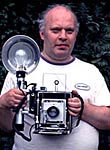|
|
 
|
|
Author
|
Topic: Kinoton PK60D Tips/Tweaks
|
|
|
Brad Miller
Administrator

Posts: 17775
From: Plano, TX (36.2 miles NW of Rockwall)
Registered: May 99
|
 posted 08-26-2004 01:53 AM
posted 08-26-2004 01:53 AM




There are others on this forum who are better qualified to answer this (Larry Shaw, Steve Guttag, Richard Fowler, etc) because I have only been working with them for a few months, but a few things off the top of my head...
When threading, have your projectionists hold the sounddrum pressure roller away from the sounddrum until the film is threaded through and laying square on the rollers before and after the sounddrum, then let the pressure roller rest against the film. We started doing this after receiving some oversize O'rings and noticed it was the inboard ones that came out of the groove and wreaked havoc on the audio. It made sense that by "sliding" the film into the track as the guys were originally doing, that the film was constantly being wiggled into place at the inboard O'ring, which I believe was a key element as to why they gave us problems so quickly. Anyway, teach your staff to thread in this manner and make sure your projectors have the green O'rings and not the evil black ones. (Kinoton is well aware that the black O'rings are missized and will replace them without question.) If yours have the black ones, alert your tech immediately to get them replaced.
Make sure your guys don't miss that roller underneath the holdback sprocket. The inching knob is large enough to block that roller from view, and if you don't stress about threading around that roller, you could accidentally scratch a print.
Watch that skate height! Get yourself a high quality set of metric T-grip allen wrenches and make damn sure the two allen wrenches that hold the skate block are tight. As you open and close the skate, these two tiny allen wrench screws like to slip clock-wise, meaning it will jack up the skate's ball pin forcing the bottom edge of the skate up against the bottom of the intermittent and that will wear your delrin skate. I am testing an idea on one of mine with great success so far, which is to loosen those two allen screws, twist the skate block as far clock-wise as it will go (it won't be much), retighten the two set screws and then set skate height. This way the skate block can't possibly twist any farther forcing the skate to ride higher if those screws come loose. It's a great idea on paper, and so far on my test projector the idea is performing wonderfully. (I can't see where time would affect it negatively either.) I think it is safe to say that if you would do a daily visual inspection on the skate height (you can do this with film running), that after 30 days have passed if they haven't slipped, they aren't going to.
On setting the skate height, the manual recommends 2 film thicknesses between the skate and the bottom of the intermittent sprocket. I prefer 3 film thicknesses, because at 2 film thicknesses it eats away at cue tape on the edge of the film due to the added thickness. (I am currently using Jack Roe pre-cut cue tape on a roll, which is thicker than Neumade's Aucuta II.) Anyway, 3 film thicknesses still provides just as steady an image as having 2 film thicknesses, so you may want to consider that.
If your automation has start cue capability, consider using it not only for the presentation's sake, but so you can re-program the inverter for a 10 or so second ramp-up in speed, rather than the factory pre-set of 5 seconds. IMHO the slower and smoother the start, the less wear there is to the components.
Don't be surprised if the machines don't perform their best right out of the crate. That's not to say that right out of the crate these projectors won't put all other machines on the market to shame (because they will), it's just that these perform better and better as hours are put on them. The skate inparticularly needs time to buff and get seated in position. Basically you will find that the more you run them, the better they perform. You have hands down the best projector being made. I'm sure you will be very pleased with them once you get used to them. ![[thumbsup]](graemlins/thumbsup.gif)
(Don't forget you have intermittent oil changes at 50 hours, 500 hours and 4000 hours/yearly.)
| IP: Logged
|
|
Michael Schaffer
"Where is the
Boardwalk Hotel?"

Posts: 4143
From: Boston, MA
Registered: Apr 2002
|
 posted 08-26-2004 04:10 AM
posted 08-26-2004 04:10 AM





quote: Brad Miller
Make sure your guys don't miss that roller underneath the holdback sprocket. The inching knob is large enough to block that roller from view, and if you don't stress about threading around that roller, you could accidentally scratch a print.
I don't understand why the American versions have this oversize inching knob in the first place. The original is the same size as the sprocket and doesn't get in the way as much. I heard that the smaller knob may lead to the shaft being bent, maybe that's why. But you have the inching button (labeled "POS" for position) anyway. When you press this, the machine will forward a few frames slowly to check the framing, then go to full speed. This feature can be configured by programming the Lenze frequency inverter already mentioned by The Brad. BTW, to program the inverter you needed an external control unit in my time. Maybe that has changed with current versions, but it would be worth checking if you still neeed it to make sure the installers have it in case you want to change the factory settings.
A simple detail many miss is that the film runner strips are symmetrical, so once they are worn down, you can reverse them left-right and use them for another round. You will see what I mean when you see the equipment.
The intermittent sometimes stops in half position, so make sure you move it a little before threading to center it, otherwise you may end up with the film starting out of frame.
One small weakness is that the lenses are held in the lens collar by little thumbscrews, and these get loose over time. So just twist them once in a while to make sure they are still tight.
Looks like you are getting the new MIT package. I looked at the console today. It has a number of nice features which will make operation and troubleshooting quite easy.
| IP: Logged
|
|
Stephen Furley
Film God

Posts: 3059
From: Coulsdon, Croydon, England
Registered: May 2002
|
 posted 08-26-2004 05:44 AM
posted 08-26-2004 05:44 AM




Michael, The FP-30Ds which I was running recently had a couple of things that I've not seen before on the older Kinotons which I've used elsewhere.
One is a small toggle switch on the control panel marked, if I remember correctly, 'F' and 'T'. What is this for?
Also, there is an XLR connector. Is this standard, or a modification of some sort, and what is it for?
I couldn't find a manual anywhere, and since they only call me in when they have nobody else to run a show, I don't often see one of the projectionists, and when I do, I always forget to ask.
In addition to the strike on motor start lamps, stupidly positioned control panel and sluggish changeovers that I mentioned in another thread, I've thought of something else that I don't like about them, the inching knob on the top sprocket, I much prefer the arrangement on the older machines, where it was near the soundhead. Other that that, nice machines.
| IP: Logged
|
|
|
|
|
|
|
|
Michael Schaffer
"Where is the
Boardwalk Hotel?"

Posts: 4143
From: Boston, MA
Registered: Apr 2002
|
 posted 08-26-2004 06:34 PM
posted 08-26-2004 06:34 PM





quote: Brad Miller
Mike, I have already changed the POS speed. It's option 39 on the Lense inverter. Ramp-up speed is either 12 or 13 (can't remember off the top of my head). You don't need anything to reprogram them.
I suspected that since you didn't mention the control unit. At the time I did the last project in Germany (a little more than 2 years ago), you still needed it.
quote: Brad Miller
Be careful about randomly tightening those little set screws on the lenses. It does affect the alignment (moreso vertically than horizontally) and assuming your apertures are sharply cut, you could end up with an aperture shadow on one edge of the screen.
I meant you should tighten them routinely, not wait until they all get loose and the lens positioning is out of alignment.
Mr Furry - That sounds like a rather older version of the FP30D. I think the last time I saw this connector was in the mid-90s or even earlier. It is like Mr Innocenti said. I even dimly remember a 3-pole balanced mono XLR, but I can't remember what it was for. Well, obviously it is for a mono sound connection, but I mean I can't remember why the machines had it. It might have been there as an option to hook up another mono sound processor to reproduce older Klangfilm mono prints. Klangfilm was a German mono sound format which didn't have the academy curve frequency roll-off.
The F/T switch might be to toggle the platter control line, for platter and changeover operation, but I am not sure. Maybe you should try what it does (not during a public show) or follow the wires inside the column to see where the wires go. I have the manuals from that period, but I left them in Germany.
| IP: Logged
|
|
|
|
|
|
All times are Central (GMT -6:00)
|
|
Powered by Infopop Corporation
UBB.classicTM
6.3.1.2
The Film-Tech Forums are designed for various members related to the cinema industry to express their opinions, viewpoints and testimonials on various products, services and events based upon speculation, personal knowledge and factual information through use, therefore all views represented here allow no liability upon the publishers of this web site and the owners of said views assume no liability for any ill will resulting from these postings. The posts made here are for educational as well as entertainment purposes and as such anyone viewing this portion of the website must accept these views as statements of the author of that opinion
and agrees to release the authors from any and all liability.
|

 Home
Home
 Products
Products
 Store
Store
 Forum
Forum
 Warehouse
Warehouse
 Contact Us
Contact Us




 Printer-friendly view of this topic
Printer-friendly view of this topic







![[thumbsup]](graemlins/thumbsup.gif)



![[Big Grin]](biggrin.gif) ) so Kinoton has the larger knob. The present Lenze unit has onboard capability to do other than factory changes.
) so Kinoton has the larger knob. The present Lenze unit has onboard capability to do other than factory changes.




